History
St. Joseph Cemetery Association
St. Joseph Cemetery, often referred to as New St. Joseph Cemetery, is located in the western hills of Cincinnati, Ohio. Nestled in a primarily residential area, the cemetery consists of 163 rolling acres and was once part of the Terry family farm.
The original St. Joseph Cemetery is located on 19.22 acres at what is now West Eighth Street and Enright Avenue. Purchased by Archbishop John B. Purcell in 1842, the land was divided, half for German Catholic burials and half for Irish Catholic burials.
As the city of Cincinnati and the neighborhood of Price Hill grew, West Eighth Street was extended through the graveyard, making it necessary to relocate some burials. Most of the displaced graves and land belonged to the Irish portion of the cemetery. St. Joseph Cemetery Association retains jurisdiction and is responsible for care of the cemetery at the North West corner of West Eighth St. and Enright Ave.

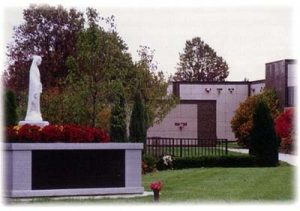 A leisurely stroll or drive through St. Joseph Cemetery today allows even the untrained eye to focus on changes in burial customs. Gone are the days when most families purchase the towering and ornate monuments and statues of former times. In some sections, only lawn level markers are permitted. A beautifully landscaped complex of outdoor mausoleums and lawn crypt gardens is a focal point of the cemetery. The mausoleums allow head to foot as well as side by side entombments. The lawn crypts accommodate two burials. These are examples of modern of serving a need as the supply of land becomes scarce. More recent additions include niches for those families who choose cremation. These niches are incorporated in the bases of shrines to the Blessed Mother and the Ascension of Jesus Christ.
A leisurely stroll or drive through St. Joseph Cemetery today allows even the untrained eye to focus on changes in burial customs. Gone are the days when most families purchase the towering and ornate monuments and statues of former times. In some sections, only lawn level markers are permitted. A beautifully landscaped complex of outdoor mausoleums and lawn crypt gardens is a focal point of the cemetery. The mausoleums allow head to foot as well as side by side entombments. The lawn crypts accommodate two burials. These are examples of modern of serving a need as the supply of land becomes scarce. More recent additions include niches for those families who choose cremation. These niches are incorporated in the bases of shrines to the Blessed Mother and the Ascension of Jesus Christ.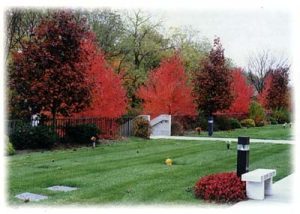 Throughout our lives, the Catholic Church has baptized us, fortified us with the Sacraments, assisted our growth and development through the schools, blessed our marriages, and anointed us in illness and death.
Throughout our lives, the Catholic Church has baptized us, fortified us with the Sacraments, assisted our growth and development through the schools, blessed our marriages, and anointed us in illness and death.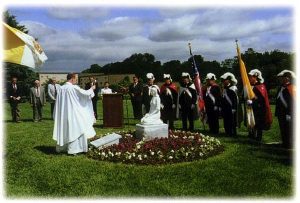 The latest addition to the grounds is a statue of Rachel, the Old Testament figure immortalized in the writings of Jeremiah. Commissioned by the Board of Trustees, it was dedicated in ceremonies on Memorial Day, 1995. “Rachel has become a symbol of healing and remembrance for those mourning lost born and unborn babies: those children known as the Holy Innocents”, the inscription proclaims. Included also is the sad verse from Jeremiah 31:15, “A voice is heard in Ramah, lamenting and weeping bitterly; it is Rachel weeping for her children because they are no more.”
The latest addition to the grounds is a statue of Rachel, the Old Testament figure immortalized in the writings of Jeremiah. Commissioned by the Board of Trustees, it was dedicated in ceremonies on Memorial Day, 1995. “Rachel has become a symbol of healing and remembrance for those mourning lost born and unborn babies: those children known as the Holy Innocents”, the inscription proclaims. Included also is the sad verse from Jeremiah 31:15, “A voice is heard in Ramah, lamenting and weeping bitterly; it is Rachel weeping for her children because they are no more.”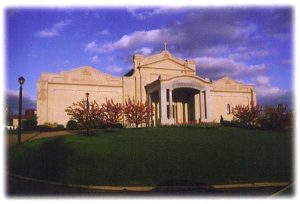 It is a little known fact that within St. Joseph Cemetery at the west end along Covedale Avenue stands a tiny cemetery within a cemetery. This small parcel was the site of the Delphi Universalist Church begun in 1838 and disbanded in 1872. All that remains are the 29 graves of the congregation’s deceased members.
It is a little known fact that within St. Joseph Cemetery at the west end along Covedale Avenue stands a tiny cemetery within a cemetery. This small parcel was the site of the Delphi Universalist Church begun in 1838 and disbanded in 1872. All that remains are the 29 graves of the congregation’s deceased members.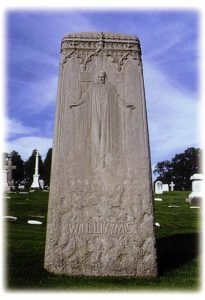 Sometime between 1929 and 1932 the Williams family of Western-Southern Life Insurance Company fame purchased a single piece of granite from Tiffany’s in New York City to mark their 30 grave plot. The monument is the largest single piece of granite in the cemetery and features Jesus stretching out his arms in an expression of love and welcome. The stone which was shipped at great expense to the fragile highway system of the time, is located in Section 1.
Sometime between 1929 and 1932 the Williams family of Western-Southern Life Insurance Company fame purchased a single piece of granite from Tiffany’s in New York City to mark their 30 grave plot. The monument is the largest single piece of granite in the cemetery and features Jesus stretching out his arms in an expression of love and welcome. The stone which was shipped at great expense to the fragile highway system of the time, is located in Section 1.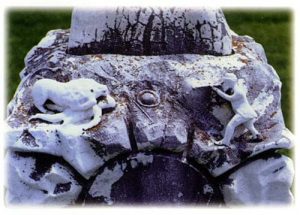 Patrick McAvoy, who died in 1906, is buried in Section 3 under an ornate, weatherbeaten stone that depicts his claim to fame in life. Patrick was employed at the Cincinnati Zoo. In the days before the zoo officially opened in September, 1875, a lioness escaped from a cage and attacked a donkey. Several employees attempted to corner the lioness but were bitten and clawed.
Patrick McAvoy, who died in 1906, is buried in Section 3 under an ornate, weatherbeaten stone that depicts his claim to fame in life. Patrick was employed at the Cincinnati Zoo. In the days before the zoo officially opened in September, 1875, a lioness escaped from a cage and attacked a donkey. Several employees attempted to corner the lioness but were bitten and clawed.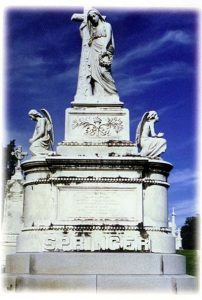 Reuben Springer, best known as the chief benefactor of Cincinnati’s famed Music Hall, was also a convert to Catholicism. Having amassed a fortune by operating the prosperous grogery house Taylor and Company, owned by his father-in-law Henry Kilgour, Mr. Springer spent much of his long life performing charitable works. It is estimated that for a considerable period of time he gave away an average of $75 a day or more than $25,000 a year before he died in 1884. The Springer monument is located in Section 1. The inscription on the stone has been erased by the weather, but prophetically it reads, “…rest from their labors for their good works follow them.”
Reuben Springer, best known as the chief benefactor of Cincinnati’s famed Music Hall, was also a convert to Catholicism. Having amassed a fortune by operating the prosperous grogery house Taylor and Company, owned by his father-in-law Henry Kilgour, Mr. Springer spent much of his long life performing charitable works. It is estimated that for a considerable period of time he gave away an average of $75 a day or more than $25,000 a year before he died in 1884. The Springer monument is located in Section 1. The inscription on the stone has been erased by the weather, but prophetically it reads, “…rest from their labors for their good works follow them.”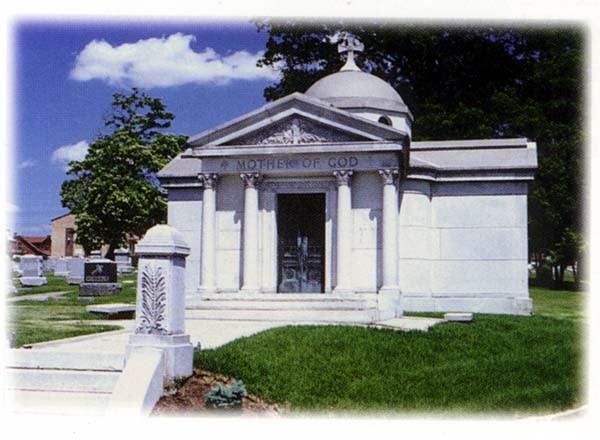
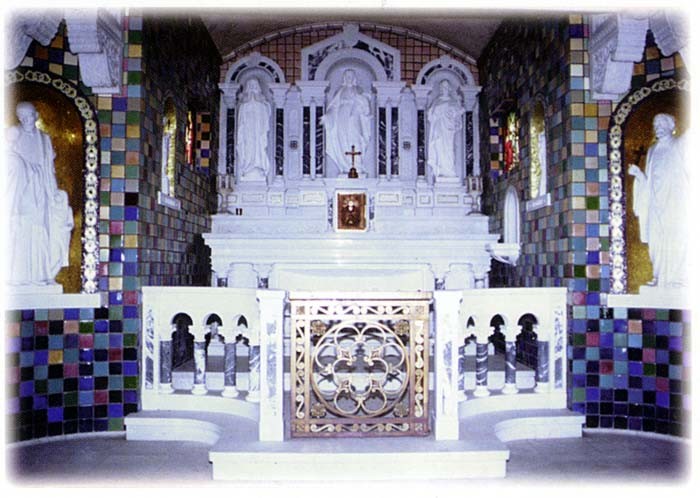
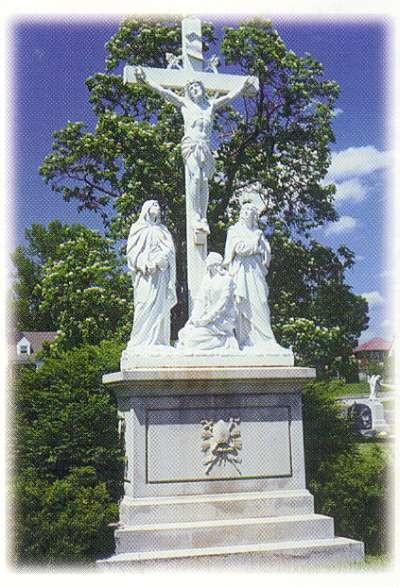 The history of St. Joseph Cemetery is filled with colorful people and interesting stories. Within it’s boundaries are found the remains of Bishop Edward D. Fenwick, a Dominican priest and the first bishop of Cincinnati; Archbishop William H. Elder, the third bishop of Cincinnati; and Archbishop Henry K. Moeller, the fourth bishop of Cincinnati.
The history of St. Joseph Cemetery is filled with colorful people and interesting stories. Within it’s boundaries are found the remains of Bishop Edward D. Fenwick, a Dominican priest and the first bishop of Cincinnati; Archbishop William H. Elder, the third bishop of Cincinnati; and Archbishop Henry K. Moeller, the fourth bishop of Cincinnati.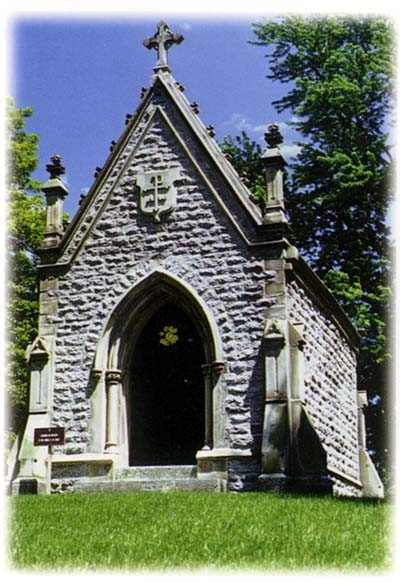 Among the least celebrated to the contemporary visitor but certainly among the most important persons in the history of the archdiocese is Mrs. Sarah Peter, who died in 1877. The eldest daughter of Thomas Worthington, sixth governor of Ohio and one-time United States Senator, Mrs. Peter converted to Catholicism following the death of her second husband. Her life is a series of good works benefiting civic, cultural and religious institutions in Cincinnati where she finally settled.
Among the least celebrated to the contemporary visitor but certainly among the most important persons in the history of the archdiocese is Mrs. Sarah Peter, who died in 1877. The eldest daughter of Thomas Worthington, sixth governor of Ohio and one-time United States Senator, Mrs. Peter converted to Catholicism following the death of her second husband. Her life is a series of good works benefiting civic, cultural and religious institutions in Cincinnati where she finally settled.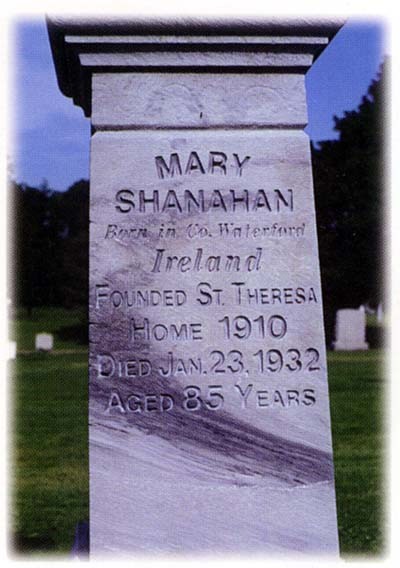 Another unknown benefactress is Mary Shanahan whose lot is located in the Southeast Plat. She made a practice of opening her home to the poor and the orphaned. Her charitable works were a constant part of her life, and in 1910 she founded St. Theresa Home. A native of County Waterford, Ireland, her legacy continues and indeed expands with the recent opening of the Mercy St. Theresa Center on the site of the former Mercy Hospital in Mariemont. Mrs. Shanahan’s family predeceased her, and the memorial inscription on her monument was just recently completed through the kindness of an anonymous donor 64 years after her death.
Another unknown benefactress is Mary Shanahan whose lot is located in the Southeast Plat. She made a practice of opening her home to the poor and the orphaned. Her charitable works were a constant part of her life, and in 1910 she founded St. Theresa Home. A native of County Waterford, Ireland, her legacy continues and indeed expands with the recent opening of the Mercy St. Theresa Center on the site of the former Mercy Hospital in Mariemont. Mrs. Shanahan’s family predeceased her, and the memorial inscription on her monument was just recently completed through the kindness of an anonymous donor 64 years after her death.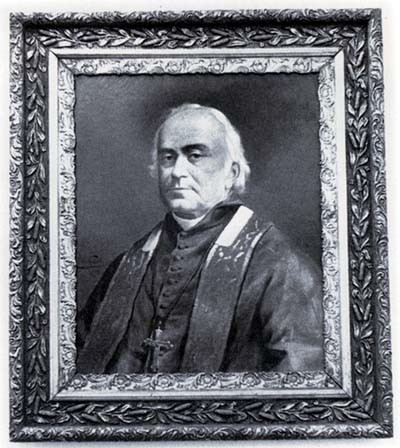 When all the lots were sold in the original St. Joseph, Archbishop Purcell bought 61.31 acres two miles west of the original site in 1853. Over the years, the cemetery has grown to 163 acres. Most of the people buried in the new grounds were of Irish and Italian descent. Since August 9, 1880, when incorporation took place, both properties fall under the auspices of The St. Joseph Cemetery Association. At that time, a single grave under four feet in length cost $4.00, over four feet $5.00. An adult internment in a plain grave was $2.00, in a box grave $3.00.
When all the lots were sold in the original St. Joseph, Archbishop Purcell bought 61.31 acres two miles west of the original site in 1853. Over the years, the cemetery has grown to 163 acres. Most of the people buried in the new grounds were of Irish and Italian descent. Since August 9, 1880, when incorporation took place, both properties fall under the auspices of The St. Joseph Cemetery Association. At that time, a single grave under four feet in length cost $4.00, over four feet $5.00. An adult internment in a plain grave was $2.00, in a box grave $3.00.